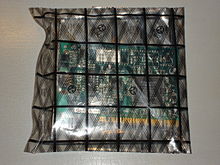靜電放電材料
外觀


靜電放電材料(ESD 材料, ESD 為 Electrostatic Discharge 的通用簡寫),或稱防靜電材料,是能夠減少靜電,以保護靜電敏感設備與易燃氣體或液體的材料,通常為一種特殊的塑膠、矽膠、或橡膠材質。
材料分類
[編輯]靜電放電材料通常依照相關特性分為以下幾類:抗靜電或稱防靜電(Anti-static)、導電(Conductive)、靜電消散(Dissipative)[1][2]
| 表面電阻 (Ω/sq)[3] |
|||||||
|---|---|---|---|---|---|---|---|
| 材料 | |||||||
| 說明 | 碳粉末與碳纖維 | 無初始電荷。提供電荷洩放的途徑。 典型顏色是黑色。 |
無或低初始電荷。 防止經由人體接觸放電。 |
初始電荷受抑制。 典型顏色是粉色。 |
絕緣體與基礎聚合物。 此類不是靜電放電材料。 |
導電
[編輯]導電材料的電阻低,因此電子可以容易的流過這些材料的表面或內部。 電荷會流向大地或與材料接觸的另一個導電物體。
靜電消散
[編輯]與導電材料相比,靜電消散材料可以使電荷以更受控的較慢方式流到大地或其他導體。
防靜電
[編輯]防靜電材料通常是指抑制摩擦生電的任何材料。 摩擦生電是由於摩擦或與另一種材料接觸而形成的靜電荷。
絕緣
[編輯]絕緣材料可防止或限制電子通過其表面或體內。 絕緣材料具有很高的電阻並且很難接地,因此不是ESD材料。 這些材料上的靜電荷會保留很長的時間。
參見
[編輯]參考資料
[編輯]- ^ Anti-Static and Conductive Plastics; Boedeker Plastics.. [2019-11-17]. (原始內容存檔於2018-06-26).
- ^ What is the Difference Between Anti-Static, Dissipative, Conductive, and Insulative?. Production Automation Corporation. 2019-11-20 [2019-11-20]. (原始內容存檔於2020-08-31).
- ^ William A. Maryniak, Toshio Uehara, Maciej A. Noras. Surface Resistivity and Surface Resistance Measurements (PDF). 2013 [2019-11-20]. (原始內容 (PDF)存檔於2020-01-10).
延伸閱讀
[編輯]- The Wiley Encyclopedia of Packaging Technology; 1st Edition; Kit. L. Yam; John Wiley & Sons; 1353 pages; 2009; ISBN 978-0-470-08704-6.
- Plastics Additives Handbook; 6th Edition; Zweifel, Maier, Schiller; Hanser Publications; 1222 pages; 2009; ISBN 978-1569904305.
- Handbook of Conducting Polymers; 3rd Edition; Skotheim and Reynolds; CRC Press; 1680 pages; 2007; ISBN 978-1574446654.
- Conductive Polymers and Plastics: In Industrial Applications; 1st Edition; Larry Rupprecht; Elsevier; 293 pages; 1999; ISBN 978-0815516569.
- Plastics Additives and Modifiers Handbook ; 1st Edition; Jesse Edenbaum; Springer; 1136 pages; 1992; ISBN 978-0442234508.
- Metal-Filled Polymers: Properties and Applications; 1st Edition; S.K. Bhattacharya; CRC Press; 376 pages; 1986; ISBN 978-0824775551.
外部鏈接
[編輯]- 抗靜電 包裝袋-甚麼原理? 開車門不用怕靜電. 實作派電子實驗室. 2019-07-29 [2019-11-20]. (原始內容存檔於2021-03-04).
- 靜電放電(ESD)與靜電放電油封材料介紹. 加耐力油封有限公司. 2019-07-29 [2019-11-20]. (原始內容存檔於2019-12-28).
- 導電ESD材料. 2012-10-10 [2019-11-20].[失效連結]
- ESD packaging advice (頁面存檔備份,存於網際網路檔案館) - Intel
- Workmanship Manual for Electrostatic Discharge Control (頁面存檔備份,存於網際網路檔案館) - NASA
